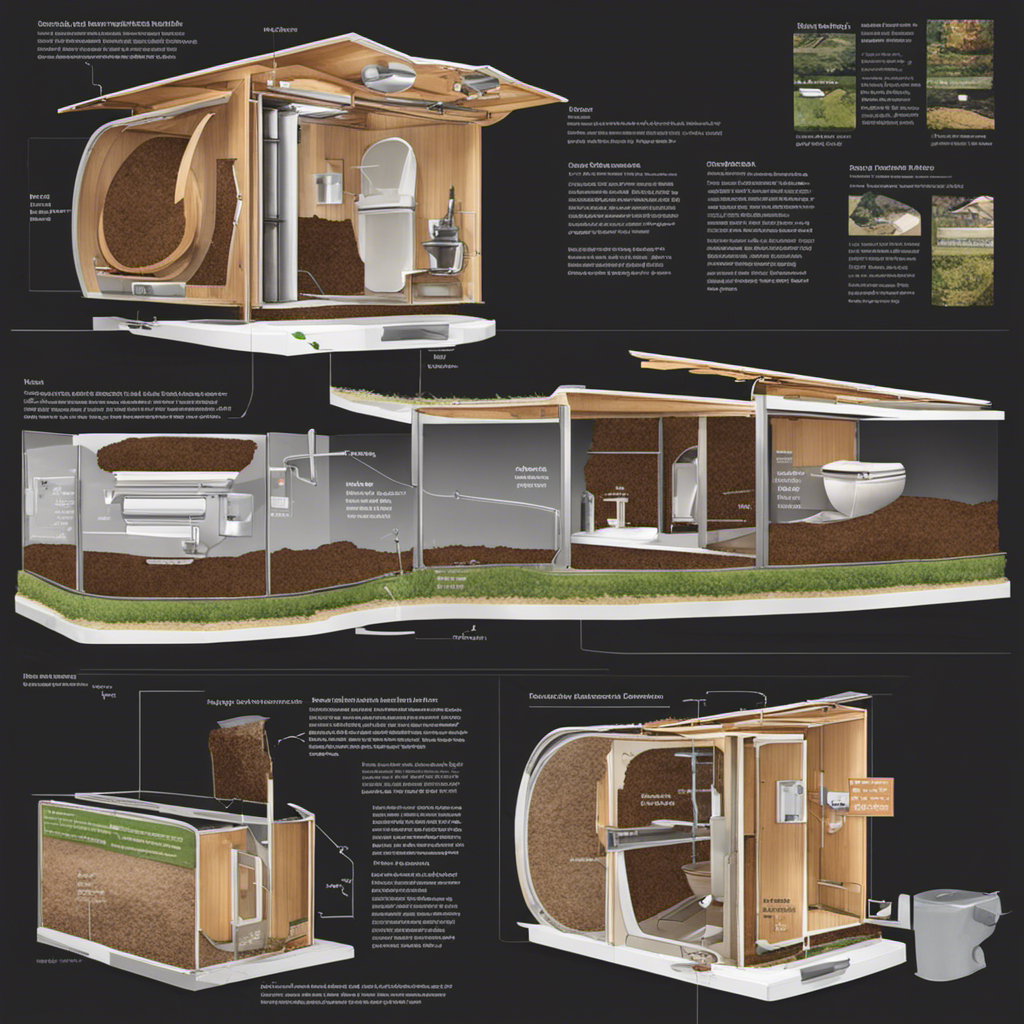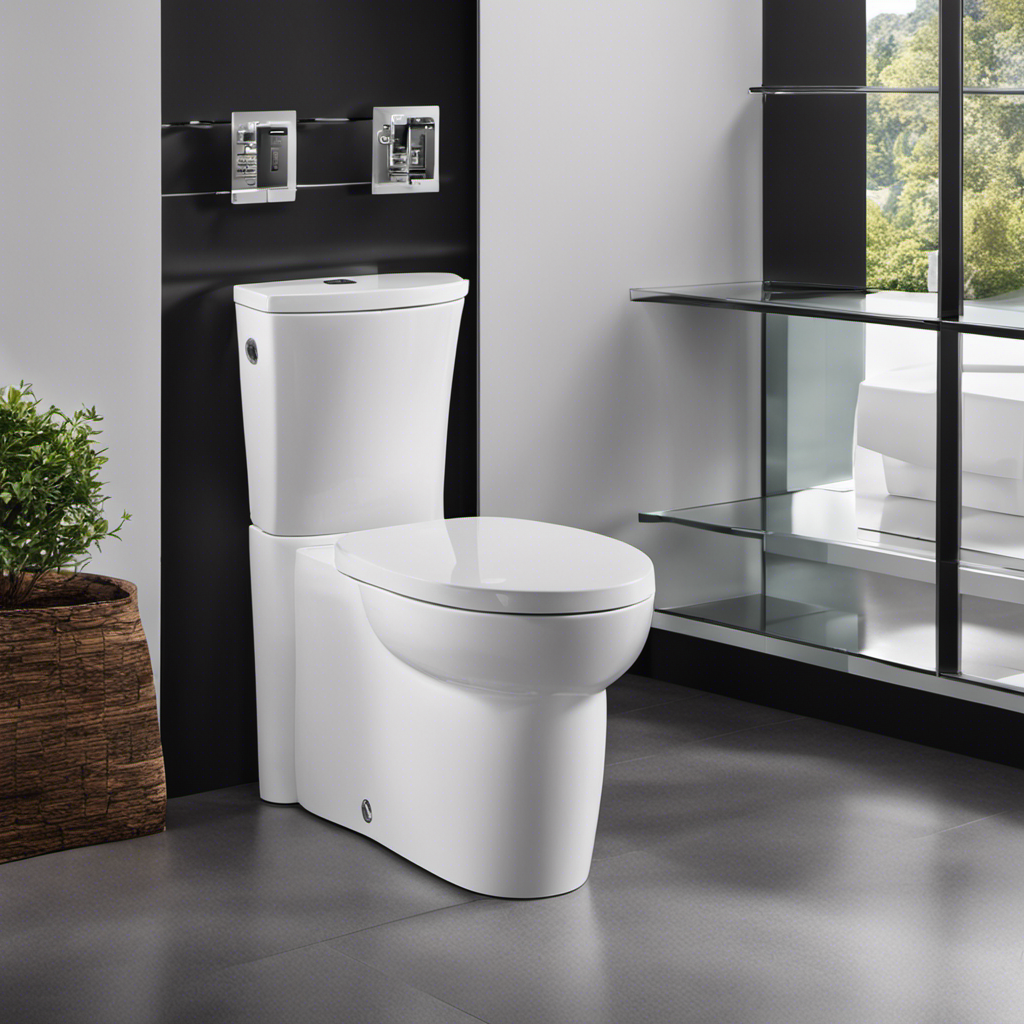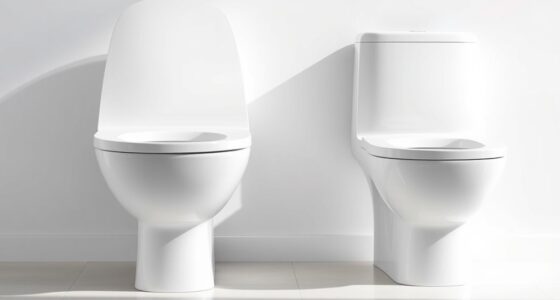As I delved into the world of sustainable living, I stumbled upon a marvel of modern ingenuity: the composting toilet. This remarkable contraption not only offers a solution for waste management, but also contributes to a greener, more eco-friendly lifestyle.
In this article, we will explore the inner workings of composting toilets, uncover the benefits they bring, and learn how to choose the right one for your needs.
Let’s dive into the fascinating world of composting toilets and discover how they work their magic.
Key Takeaways
- Composting toilets use natural processes like bacteria and fungi to break down waste into nutrient-rich compost.
- They help reduce pollution caused by traditional sewage systems, which can contaminate water sources.
- Composting toilets conserve water as they don’t require flushing.
- The compost produced can be used as fertilizer, reducing the need for chemical fertilizers.
Benefits of Composting Toilets
You’ll be pleased to know that composting toilets offer a wide range of benefits.
Composting toilet design focuses on the efficient decomposition of human waste, turning it into a valuable resource. These toilets use natural processes to break down waste, such as bacteria and fungi, creating nutrient-rich compost. This compost can then be used as fertilizer for plants, reducing the need for chemical fertilizers.
Composting toilets also conserve water, as they don’t require any flushing. This makes them a sustainable and eco-friendly option, especially in areas with water scarcity.
Additionally, composting toilets help reduce the pollution caused by traditional sewage systems, which can contaminate water sources. Composting toilet regulations ensure that these systems are properly maintained to ensure hygiene and safety.
Overall, composting toilets provide an innovative solution for waste management, promoting sustainability and protecting the environment.
Components of a Composting Toilet System
The components of a composting toilet system include a ventilation fan, a waste container, and a biofilter.
The ventilation fan helps to maintain airflow and remove moisture from the system, preventing the growth of odor-causing bacteria.
The waste container, often referred to as the composting chamber, is where the waste is collected and allowed to decompose.
It is important to regularly maintain the composting toilet system to ensure proper functioning and control odors.
This includes emptying the waste container when it reaches its capacity, adding organic material such as sawdust or peat moss to aid in the decomposition process, and monitoring the moisture levels to prevent excessive dryness or wetness.
The Composting Process in a Composting Toilet
In a composting toilet system, organic waste is broken down through the process of decomposition, creating nutrient-rich compost. This process involves the activity of microorganisms that naturally occur in the waste.
Here is a brief overview of the composting process in a composting toilet:
-
Aerobic Environment: Composting toilets are designed to promote aerobic conditions, allowing oxygen-loving bacteria to thrive and break down the waste effectively.
-
Moisture Control: Proper moisture levels are crucial for composting. Composting toilets are designed to regulate moisture, ensuring an optimal environment for decomposition.
-
Temperature Regulation: Composting is most efficient at temperatures between 50 and 60 degrees Celsius. Composting toilet designs often incorporate insulation to maintain these temperatures.
Maintenance and Care for a Composting Toilet
Proper maintenance and care for a composting toilet system are essential to ensure its longevity and efficiency. As a user of a composting toilet, I understand the importance of following maintenance tips and having a troubleshooting guide readily available. Here are some key maintenance tips to keep your composting toilet running smoothly:
- Regularly empty the solids and liquids containers to prevent overflow and odor buildup.
- Add bulking agents, such as sawdust or coconut coir, to aid in the composting process.
- Monitor the temperature and moisture levels to ensure optimal composting conditions.
In case you encounter any issues with your composting toilet, refer to the troubleshooting guide below:
| Issue | Possible Cause | Solution |
|---|---|---|
| Odor | Poor ventilation | Check ventilation system and improve airflow |
| Flies or pests | Improper waste separation | Ensure proper separation of waste |
| Slow composting process | Incorrect carbon-to-nitrogen ratio | Adjust the ratio or add more bulking agents |
Choosing the Right Composting Toilet for Your Needs
When it comes to choosing the right composting toilet for your needs, there are two key points to consider: size and capacity, and installation requirements.
Size and capacity refer to the physical dimensions of the toilet as well as its ability to handle the waste produced.
Installation requirements include factors such as the need for plumbing connections, ventilation systems, and space for the toilet unit.
Considering these factors will ensure that you select a composting toilet that fits your space and meets your waste management needs.
Size and Capacity
To determine the size and capacity of your composting toilet, you’ll need to consider the amount of waste you generate on a daily basis. The toilet design plays a crucial role in how efficiently it can handle and break down the waste. Here are three factors to consider:
-
Ventilation system: A well-designed composting toilet will have a ventilation system that helps control odor by promoting airflow and preventing the buildup of harmful gases.
-
Composting chamber: The size of the composting chamber determines how much waste it can hold and how long it takes to decompose. A larger chamber allows for more waste storage and longer composting cycles.
-
Liquid separation system: Some composting toilets have a separate compartment for urine, which helps in odor control and prevents excessive moisture in the composting chamber.
Considering these factors will help you choose a composting toilet that suits your needs and ensures efficient waste management. Now, let’s move on to the installation requirements.
Installation Requirements
For installation, you’ll need to make sure you have the necessary tools and materials on hand.
The installation process of a composting toilet involves a few key steps. Firstly, you’ll need to choose a suitable location for the toilet, ensuring it is well-ventilated and accessible for maintenance.
Next, gather the necessary tools such as a screwdriver, level, and wrench. Additionally, you will need materials like sealing tape, screws, and a ventilation pipe.
Begin by assembling the toilet according to the manufacturer’s instructions. Next, connect the ventilation pipe to ensure proper airflow. Finally, secure the toilet to the floor using screws and sealing tape to prevent leaks.
It is important to follow the installation process carefully to ensure the toilet functions effectively and safely.
Environmental Impact of Using Composting Toilets
Composting toilets offer a range of benefits that contribute to environmental sustainability.
Firstly, they provide an efficient way to reduce waste by converting human waste into nutrient-rich compost. This not only reduces the amount of waste that goes to landfills but also promotes recycling and the use of organic materials for soil enrichment.
Additionally, composting toilets help conserve water by eliminating the need for traditional flushing mechanisms, making them a valuable alternative in water-scarce areas.
Benefits of Composting Toilets
One of the benefits of composting toilets is that they can help reduce water usage.
In addition, these toilets offer the following advantages:
-
Composting toilet design: Composting toilets are specifically designed to facilitate the decomposition process of human waste. They contain separate compartments for solid and liquid waste, allowing for efficient decomposition and odor control.
-
Environmental sustainability: Composting toilets contribute to a more sustainable environment by reducing the amount of water used for flushing. This is particularly beneficial in areas where water scarcity is a concern.
-
Composting toilet regulations: Many countries and regions have regulations in place to ensure the safe and effective use of composting toilets. These regulations address factors such as proper waste management, maintenance, and hygiene practices.
Composting toilets not only save water but also promote environmental sustainability while adhering to specific regulations. Their design and functionality make them an attractive option for those looking to reduce their water footprint and contribute to a more sustainable future.
Waste Reduction and Recycling
If you want to reduce waste and recycle more, there are several strategies you can implement in your daily life.
Waste management is crucial for a sustainable environment. One effective method is organic waste decomposition. By composting your food scraps and yard waste, you can divert a significant amount of waste from landfills.
Composting is a natural process where microorganisms break down organic materials into nutrient-rich soil. This process not only reduces the volume of waste but also creates a valuable resource for gardening and landscaping.
To start composting, simply gather your organic waste, such as fruit and vegetable peels, coffee grounds, and leaves, in a compost bin. Turn the pile regularly to provide oxygen and maintain proper moisture levels.
With this simple strategy, you can contribute to waste reduction and create a beneficial product for your garden.
Water Conservation Advantages
To conserve water in your daily routine, you can start by fixing leaky faucets and using low-flow showerheads and toilets. These simple changes can have a big impact on water conservation and sustainable living.
Here are three reasons why water conservation is important:
-
Reduces water waste: By fixing leaky faucets and using low-flow fixtures, we can prevent water from being wasted unnecessarily. This helps to conserve this precious resource and ensure its availability for future generations.
-
Saves money: Using less water means lower water bills. By adopting water-saving practices, we can not only help the environment but also save money in the long run.
-
Protects ecosystems: Conserving water reduces the strain on ecosystems, such as rivers, lakes, and wetlands. By using water responsibly, we can help maintain a healthy balance in these natural habitats.
Frequently Asked Questions
Are Composting Toilets Legal in All Areas?
Composting toilet regulations vary by location, but they are legal in many areas. These toilets offer numerous benefits in rural areas, such as water conservation, nutrient-rich compost production, and reduced environmental impact.
How Often Should the Compost Be Emptied From a Composting Toilet?
I empty the compost from my composting toilet every few months. Regular maintenance is important for optimal functioning. Composting toilets offer numerous benefits, including reduced water usage and the production of nutrient-rich compost for gardening.
Can Composting Toilets Be Used in Cold Climates?
Yes, composting toilets can be used in cold climates. However, the efficiency of composting and maintenance may be affected by the lower temperatures. Regular monitoring and appropriate insulation can help ensure proper functioning.
Can Composting Toilets Handle Heavy Usage, Such as in a Public Restroom?
Composting toilets can handle heavy usage in public restrooms with proper maintenance. They offer numerous benefits, such as reducing water consumption, eliminating sewage infrastructure needs, and producing nutrient-rich compost for agriculture or landscaping.
Are Composting Toilets Suitable for Households With Young Children or Elderly Individuals?
Composting toilets are safe and beneficial for households with young children or elderly individuals. They provide a sustainable and eco-friendly way to dispose of waste, reducing the risk of contamination and promoting a healthier environment for all.
Conclusion
In conclusion, composting toilets are an environmentally-friendly option for waste management. Their efficient system and natural composting process make them a sustainable choice.
By eliminating the need for water and reducing sewage waste, composting toilets contribute to water conservation and decrease pollution.
With proper maintenance and care, these toilets can be a long-lasting and cost-effective solution.
So, for those seeking a sustainable and efficient way to handle waste, composting toilets are the way to go!










